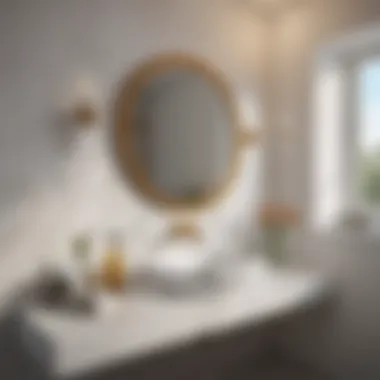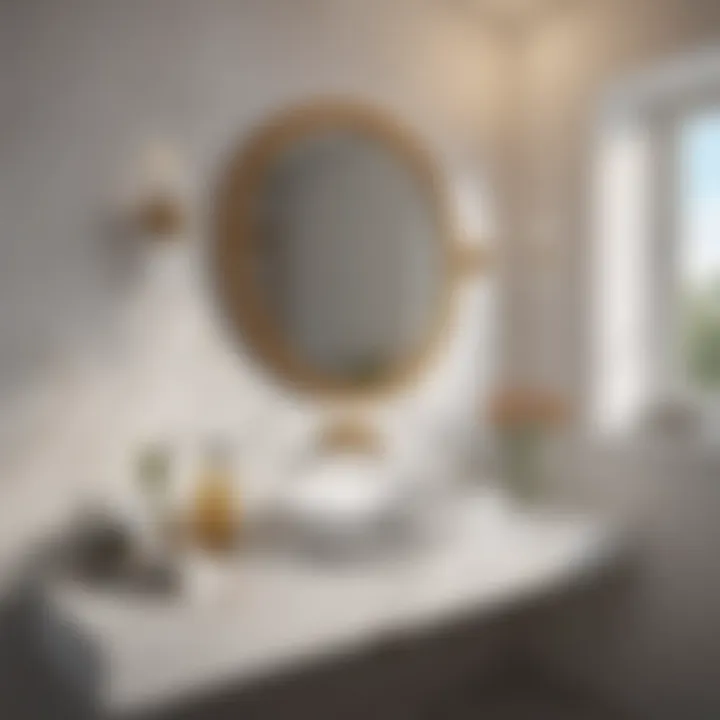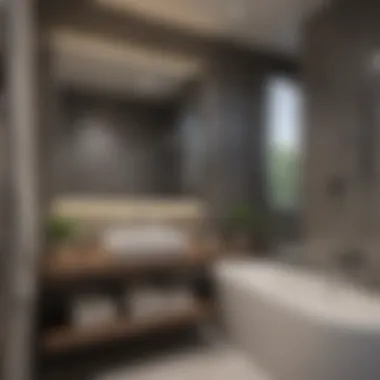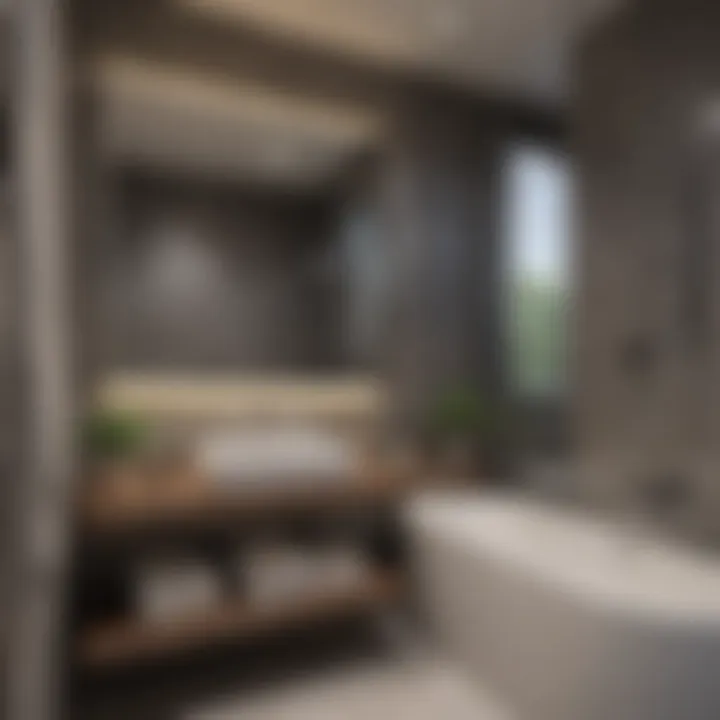Smart and Stylish Solutions for Small Bathrooms


Intro
In the realm of home design, bathrooms often get sidelined when it comes to showcasing personality and comfort. However, when space is at a premium, this becomes an even bigger issue. Small bathrooms may seem daunting to style and organize, but with the right approach, these compact areas can shine with functionality and flair. This guide dives into innovative ideas that embrace creativity, turning small bathrooms into personal retreats. For homeowners, especially those managing busy households, understanding how to optimize these snug spaces can redefine daily routines significantly.
Current Trends
Color Palettes
The influence of color in small bathrooms is profound. While cozy can be the aim, certain colors expand the perception of space.
- Light neutrals such as soft grays or creamy whites are popular for a fresh, clean look.
- Pastel shades can invite calmness, with light blues and greens enhancing serenity.
- Bold accents, like deep navy or emerald green, create a striking contrast against lighter tones and can add drama without overwhelming the senses.
Popular Styles
The style of a bathroom sets the tone and reflects personal taste. Here are a few styles trending among homeowners looking to maximize small spaces:
- Minimalist: Focuses on simplicity where less really is more. Clean lines, uncluttered surfaces, and functional fixtures shape this look well.
- Vintage: Incorporating retro elements, such as clawfoot tubs or patterned tiles, can invoke a nostalgic charm while maintaining quirky functionality.
- Modern Farmhouse: A mixture of rustic simplicity and elegance, this style pairs well with natural materials like wood and stone, promoting warmth even in smaller formats.
Visual Ideas
Gallery of Styled Bathrooms
Exploring visual inspiration can ignite creativity for one’s own space. Small bathrooms designed with a mix of color and clever layouts can offer easy ways to implement similar styles.
- Photo collections on sites like Pinterest can provide endless ideas, showcasing everything from sleek fixtures to inventive storage solutions.
- Consider visiting platforms like Instagram for real-time updates and trendy transformations that inspire.
Before-and-After Transformations
Witnessing a transformation can be encouraging. Before-and-after image collections reveal how strategic changes elevate not just the bathroom’s look but also its functionality.
Before: Dark colors made the bathroom feel cramped and uninviting.
After: A light palette with well-placed mirrors and modern fixtures transformed it into a bright space.
- Simple swaps like changing out a shower curtain or adding a more streamlined vanity can yield significant impacts.
- Investing in multifunctional furniture, like ottomans that double as storage, can mirror success stories highlighted online.
Maintaining a stunningly manicured small bathroom is about maximizing each inch while reflecting personal taste. As trends evolve, so do techniques to take advantage of every square foot.
Adjusting color schemes, styles, and visual inspiration can lead to a bathroom that feels expansive and luxuriously thoughtful, despite its size.
Understanding Small Bathroom Challenges
When dealing with a small bathroom, the challenges can feel a bit like trying to fit a square peg in a round hole. The limited space often forces homeowners to engage in creative thinking. Understanding these challenges is crucial, not only for optimizing functionality but also for creating a visually appealing sanctuary. The most important aspects to consider include the layout, storage solutions, and multi-functional features that can make a compact area feel more expansive and practical.
Common Space Constraints
Small bathrooms typically feature constraints that make traditional designs difficult. With limited real estate, the need for smart planning becomes paramount. Often, homeowners find themselves grappling with fixtures that consume more room than they should. For instance, standard-sized bathtubs can easily dominate a small bathroom, leaving hardly any breathing space.
What about odd angles, the pesky support beams, or insufficient natural light? These are not just inconveniences; they are realities that need addressing.
- Identifying Measurements: Before making any decisions, taking the measurements of existing spaces is non-negotiable. Knowing dimensions helps in selecting appropriate fixtures.
- Visual Illusions: Using light colors or large-format tiles can trick the eye into perceiving higher ceilings and wider spaces.
"Size does matter, but so do choices. Clever solutions can make a small bathroom feel almost grand."
Designing for Multiple Functions
In a world where homes often serve multiple purposes, small bathrooms must be no exception. The challenge here is to design a space that accommodates several functions simultaneously without feeling cramped or cluttered. When one area serves multiple needs, like a sink doubling as a makeup station or a bathtub incorporating a built-in shelf, every inch gains importance.
- Smart Fixtures: Choosing compact, wall-mounted toilets can free up valuable floor space, allowing for more room around the bathroom.
- Flexible Furnishings: Consider investing in foldable chairs or nested tables that can be tucked away immediately after use.
By integrating thoughtful designs like these, you can ultimately create an environment that not only meets your everyday needs but also makes small tasks feel effortless. Achieving harmony in such tight quarters goes beyond just concern for aesthetics; it becomes essential for daily life.
Layout Strategies
Designing a small bathroom is like putting together a jigsaw puzzle; each piece must fit perfectly to create a harmonious whole. Layout strategies serve as the foundation for this delicate balancing act, ensuring that every inch is utilized effectively. A well-thought-through layout not only maximizes space but also enhances functionality and aesthetics. The right layout can lead to improved traffic flow, easier cleaning, and a more pleasant overall experience. Here, we will explore some of the key strategies to optimize your small bathroom’s layout.
Optimizing Floor Plans
When dealing with limited space, floor plan optimization is crucial. Corners often go underutilized, but they can become hidden gems in your bathroom design. Consider using corner sinks or triangular shelves to make the most of those neglected areas. Moreover, floating vanities can create an illusion of space by allowing visibility underneath.
"The right floor plan transforms more than just the bathroom; it can change your entire experience within that space."
Key considerations for floor plan optimization include:
- Flow: Ensure that doors, cabinets, and fixtures do not obstruct pathways. An open flow aids accessibility and comfort.
- Functional Zones: Group facilities such as the toilet, shower, and sink logically. This zoning can make your routines smoother.
- Compact Fixtures: Invest in slender profile fixtures like a narrow toilet or a mini basin to gain extra room without sacrificing utility.
Zoning Techniques
Introducing zoning techniques into your small bathroom can make a world of difference. By clearly defining areas for different functions, you can create a sense of order, making even the smallest spaces feel organized and spacious. Think about using flooring transitions or color changes to delineate zones. For instance, a different tile below the sink can create a distinct area without putting up walls.
There are effective methods to achieve practical zoning:


- Half Walls: Instead of completely closed walls, half walls can create a division while still keeping the space airy. They provide privacy without blocking light.
- Curtains or Screens: A lightweight curtain can separate the shower from the rest of the bathroom, helping contain wetness while adding a splash of color.
- Differences in Lighting: Use varying light sources to highlight specific zones. Soft lights above the mirror can create a relaxing atmosphere while bright, task-oriented lights can enhance visibility in the shower area.
Vertical Space Utilization
In small bathrooms, thinking vertically can unlock a treasure trove of possibilities. Utilizing vertical space means reaching up rather than just spreading out. High shelves, tall cabinets, and wall-mounted storage can free floor areas, making the space less cramped. By focusing on height, one can turn every inch of the wall into functional space.
Some clever ideas for vertical space utilization include:
- Wall-mounted Towel Bars: These not only save space but can also be decorative.
- Ladder Shelves: A cute, yet efficient way to store towels, plants, or decorative items while making full use of height.
- Over-the-door organizers: Perfect for toiletries, these save sink space and keep essentials handy without cluttering surfaces.
By integrating these layout strategies into your small bathroom design, you can not only maximize functionality but also enhance its overall charm, creating the perfect retreat without skimping on style.
Storage Solutions
In a small bathroom, every square inch counts. The right storage solutions can make the difference between a cramped, chaotic space and a serene, organized retreat. Effective storage not only declutters but also maximizes functionality, allowing for a streamlined aesthetic that can be quite refreshing. Thoughtful storage solutions enhance the experience, making the bathroom feel more spacious and inviting, ultimately contributes to the overall ambiance.
"Good storage is about making the most of what you have while making it look good; it’s like finding gold in a haystack!"
Built-in Alternatives
Built-in options are the unsung heroes of bathroom organization. They often blend seamlessly with existing architecture, providing storage without compromising precious floor space. Consider installing a recessed niche in the shower area. This allows for a sleek way to hold toiletries, keeping them within reach while ensuring the walls remain clean and open.
Another practical built-in solution is shallow cabinets or shelves that can fit snugly above the toilet. They can hold everything from extra toilet paper to decor, making the most of what is often an overlooked area. Utilizing every corner and crevice efficiently can create a much more airy feel.
Creative Shelving Ideas
When thinking about shelving, creativity goes a long way—especially in a small bathroom. Floating shelves can be a game changer. They free up floor space while adding dimension to the walls. Installing them at varying heights adds a unique flair, allowing for both decorative and functional items. Picture vibrant plants, innovative soaps, and candles that compliment the color scheme—you have a gallery and storage solution in one.
Let’s not forget about corner shelves, which can utilize space that is often left bare. Curly or geometric designed shelves can bring in style. They can carry a few essential items, while also serving as a focal point. Combining aesthetics with function is key in maximizing effectiveness in storing supplies.
Under-sink Innovations
The area beneath the sink adds a new dimension to storage options. Instead of just letting this space serve as a hidden junk drawer, innovative alterations can turn it into an efficient hub. Installing a pull-out drawer system can provide easy access to cleaning products, extra toiletries, or even towels, without the hassle of rummaging around.
Another option is using stackable bins, which can help separate different kinds of items. Labeling them can be a terrific way to keep track of what goes where, reducing the time spent looking for specific products.
Incorporating a curtain instead of a traditional cabinet door can add a relaxed, casual vibe, while also providing easy access. The fabric can match the bathroom’s theme, making it stylish as well as practical.
Color and Light
When it comes to small bathrooms, the interplay between color and light can make or break the space. It’s no secret that the right hues and effective lighting can transform a cramped area into a sanctuary that feels open, inviting, and even spacious. Colors have a unique ability to influence mood and perceived space, so making smart choices here is paramount. Bright, reflective surfaces can enhance natural light, creating an atmosphere that uplifts and relaxes at the same time. Conversely, darker colors, while sometimes dramatic, can quickly make a small room feel even more confined if not balanced correctly.
Choosing the Right Color Palette
Selecting an appropriate color palette is more than just personal taste; it’s vital for setting the tone of your small bathroom. Light shades tend to reflect light, giving your space a luminous quality. Soft whites, pale blues, and muted greens can enhance the feeling of airiness.
Here are some tips for choosing the right color palette:
- Consider Natural Light: Pay attention to how much natural light the room receives. North-facing bathrooms, for example, can benefit from warmer tones to counteract the cool light.
- Monochromatic Schemes: A one-color scheme can help to create continuity and make the space appear larger. Think about varying the shades of a single color for depth without the visual clutter.
- Accent Features: Use bolder colors, perhaps on a single wall or through accessories, to draw the eye and provide personality without overwhelming.
Choosing wisely also means understanding your personal style, and how that meshes with functionality.
Lighting Solutions for Small Spaces
Lighting is crucial in small bathrooms. The right fixtures not only brighten the space but also contribute to the overall design. Layers of light can strategically highlight different aspects of your bathroom, making it feel comfortable and functional.
Consider these lighting approaches:
- Ambient Lighting: This serves as your primary light source. Recessed lights or overhead fixtures with a dimming option can provide broad illumination, which is especially that helpful during morning routines.
- Task Lighting: Focus on areas where detailed tasks are performed, such as around mirrors. Wall sconces or backlit mirrors can shed light where it’s needed without adding to shadows.
- Accent Lighting: This type highlights architectural details or decorative elements, adding character and flair to your bathroom.
A good mix of these lighting solutions will ensure that practicality meets aesthetics, ultimately crafting an inviting retreat.
Mirror Placement Techniques
Mirrors aren’t just functional; they are the unsung heroes of small bathrooms as they can create the illusion of depth and space. Strategically placing mirrors will amplify both natural and artificial light, enhancing the brightness of the area.
To maximize the impact of your mirrors:
- Opposite a Window: Positioning a mirror directly across from a window allows light to bounce around the room, effectively doubling the brightness.
- Overwash Basins: Placing a large mirror over the sink area can inspire a sense of openness. Large mirrors are often preferable, as they reflect more of the room’s space.
- Layering Techniques: Using multiple smaller mirrors in various shapes can add interest and help to visually expand the area.
It’s important to consider what you want the mirror to reflect, as it can either open up the space or highlight clutter if not done thoughtfully.
"The right choices in color and light can take a small bathroom from cramped to cozy; it’s all about knowing how to play the cards right."
By understanding and implementing effective use of color palettes, lighting, and mirror placements, your small bathroom can be transformed into a functional yet stylish oasis.
Materials and Finishes
In the realm of small bathrooms, the choice of materials and finishes stands as a cornerstone in achieving both functionality and style. These decisions can drastically affect the visual aesthetic and practical use of limited space. Selecting the right materials is not just about looking good; it's about durability, maintenance, and how they can enhance the overall experience of the space. Imagine a bathroom where every tile, fixture, and finish not only serves its purpose but also paints a picture of elegance and efficiency.


Opting for space-efficient materials can mean the difference between a cramped feeling and an airy retreat. Key considerations include choosing finishes that are easy to clean, resistant to moisture, and available in lighter tones to reflect light—qualities that are essential in a small space that is often poorly lit.
Here are some benefits of focusing on the right materials and finishes:
- Durability: Investing in stronger materials can reduce the need for frequent replacements.
- Maintenance: Less porous materials lead to easier cleaning, saving time and effort in upkeep.
- Light Reflection: Glossy finishes can help brighten up small spaces, making them appear larger and more inviting.
Selecting Space-efficient Materials
When it comes to selecting space-efficient materials, neutral tones and reflective surfaces play a key role. These choices can create a sense of continuity and openness, attributes that are essential in small bathrooms. For instance, large-format tiles can minimize grout lines and create a seamless look, which enhances the visual flow of the space.
Instead of ornate, bulky fixtures, consider streamlined options that have a minimal footprint while maximizing utility. For example:
- Wall-mounted sinks can save valuable floor space and offer ease of cleaning beneath.
- Floating vanities provide storage without the bulk, making a room feel lighter visually.
- Frameless glass showers can maintain an open and airy feel while still ensuring necessary privacy.
"In a small bathroom, every choice counts. Selecting the right materials can transform a mundane space into a sleek haven."
Trends in Wall and Floor Finishes
Trends in wall and floor finishes are ever-evolving, revealing new ways to utilize materials that blend functionality with style. Currently, textured tiles have gained significant popularity. They not only add an element of depth but also can help in hiding imperfections that often plague small bathroom walls. So if you're dealing with an older home or unlevel walls, this is definitely a route worth considering.
When it comes to floor finishes, vinyl and laminate have emerged as top choices due to their ability to imitate more expensive materials like wood or stone while remaining more affordable and easier to maintain. Additionally, these materials are often water-resistant, which is a must in a bathroom setting. Here are some key trends to watch for:
- Eclectic patterns: Mixing and matching tiles can add personality, allowing you to express your style while being functional.
- Nature-inspired colors: Earthy tones help to create a calming atmosphere, enhancing the feeling of relaxation.
- Sustainable options: More homeowners are moving towards recycled materials, ensuring that their bathrooms are not just beautiful but also eco-friendly.
In summary, when choosing materials and finishes for your bathroom, keep in mind not just the looks, but also the maintenance and longevity. The right combination can turn that small bathroom into a space that feels larger, more stylish, and ultimately—more you.
Decorative Elements
Decorative elements play a pivotal role in transforming a small bathroom from being merely functional to a personal sanctuary. These enhancements allow homeowners to inject their style while simultaneously addressing the limitations of space. By incorporating thoughtful decorations, one can define the character of the bathroom, creating a haven that remains both beautiful and efficient. The right elements not only elevate the aesthetic appeal but can also serve practical purposes, making every inch count.
Incorporating Art and Accessories
When it comes to small bathrooms, choosing the right art and accessories can make a significant difference. Think about framed prints or canvas art that resonate with your personal taste. A well-placed piece above a towel rack can draw the eye upward, thus creating an illusion of height. Additionally, decorative mirrors can amplify the light, enhancing the open feeling.
Consider integrating smaller accessories that also serve a purpose. For instance, chic storage baskets can keep toiletries tidy while adding a touch of texture. Wall-mounted shelves can showcase carefully chosen decor items, like small potted plants or scented candles, which provide a pleasant ambiance. Just avoid cluttering; simplicity often reigns supreme in small spaces.
"Small spaces must be curated with care, making each piece count."
In selecting accessories, it's crucial to choose a cohesive color palette that complements your existing fixtures and finishes. It draws the whole look together without overwhelming the senses.
Textiles for Comfort and Style
Textiles are another key component for enhancing comfort and style in small bathrooms. While functionality is important, fabrics can introduce warmth and a layer of coziness that tiles and fixtures often lack. Opt for bath mats, towels, and window treatments that align with your chosen aesthetic.
For small bathrooms, consider lightweight curtains instead of heavy drapes. This choice can allow natural light to seep in, making the space feel more open. Coordinate your towels and other fabrics in complementary hues. This not only provides a polished look but also infuses a sense of harmony into the design.
Textiles do not need to be bland; rich textures can create depth. Fabrics like linen or organic cotton for towel sets can add a hint of luxury without taking away from the limited space.
To summarize, by thoughtfully combining art, accessories, and textiles, small bathrooms can evolve into spaces that are not just functional but also uniquely yours. The choices you make in decorating can enhance the usability and create a pleasant ambiance, showing that a little creativity goes a long way.
Innovative Fixtures
In the realm of small bathrooms, innovative fixtures can be the cherry on top, transforming a cramped space into a functional and stylish retreat. These fixtures play a crucial role in maximizing utility while ensuring aesthetic appeal. When space is at a premium, it becomes essential to consider not only the practicality of each item but also how they contribute to the overall ambiance of the room.
By opting for innovative options, homeowners can tackle common issues like limited space and poor storage while maintaining a polished look. Every fixture should be meticulously chosen for both its function and style, as this can make a world of difference in how the room is perceived.
Compact Bathtubs and Showers
Compact bathtubs and showers are redefining how we approach bathing spaces in small bathrooms. The traditional bulky tub isn’t always the best fit, and alternatives now abound that are more space-efficient without sacrificing comfort. You can find models that are shorter in length or wider with deeper designs, allowing one to enjoy a soak without feeling like a sardine.
Choosing a compact bathtub provides a cozy spot for relaxation while ensuring that more floor space is available for other fixtures or storage. Likewise, compact and corner showers maximize the use of available room.
Here are some key benefits to consider:
- Space-saving design: Compact models often fit snugly into corners or against walls, which frees up valuable square footage.
- Style versatility: Many modern bathtubs and showers come in sleek designs that enhance the visual appeal of your bathroom.
- Easy cleaning: Smaller surfaces mean less area to clean.
- Diverse styles: Options like walk-in showers or small freestanding tubs can match various themes, from minimalist to luxurious.
Though they save space, it’s crucial to measure carefully before purchase to ensure the chosen fixture fits like a glove. Poor planning can leave you with a unit that’s too big or out of proportion, which diminishes the overall impact of the design.
Wall-mounted Toilets
Wall-mounted toilets are a fantastic option for small bathrooms, and they go hand-in-hand with sleek design and space efficiency. These toilets are not just trendy; they provide a range of advantages that can revamp your bathroom's layout entirely. The bathroom does not just become more functional; it gains a modern look.
Unlike the standard floor-mounted options, wall-mounted toilets free up floor space. This not only makes cleaning easier but also creates an illusion of more room. Below are some factors to keep in mind when considering wall-mounted toilets:
- Space Efficiency: The tank is flushed and hidden inside the wall, allowing for a minimalist appearance.
- Increased Accessibility: They can be installed at varying heights to accommodate everyone’s needs.
- Enhanced Cleaning: With no base on the floor, cleaning becomes a breeze.
- Sleek Aesthetic: They fit seamlessly into almost any bathroom design, lending a sophisticated touch.
However, as with any departure from traditional fixtures, installation might require professional help to ensure everything is up to code. While they do represent a higher initial investment, the long-term benefits in both style and usability often outweigh the costs.
"Innovative fixtures like compact bathtubs and wall-mounted toilets represent not just a trend, but a shift toward a more thoughtful use of space."


In summation, the deliberate selection of innovative fixtures in small bathrooms can elevate the experience while ensuring that the necessary functionalities are met. By thinking outside the proverbial box, homeowners can create spaces that are as beautiful as they are practical, ultimately turning limitations into opportunities.
Maintenance and Care
Taking care of a small bathroom is something many homeowners often overlook, thinking that since the space is small, it doesn’t require much attention. However, maintenance is paramount, especially in compact spaces where every nook and cranny can trap moisture, dirt, and grime. By implementing smart cleaning strategies and selecting durable materials, the longevity of your bathroom can be significantly enhanced, ensuring that it remains a serene retreat rather than a breeding ground for mold and deterioration.
Cleaning Strategies for Small Bathrooms
Keeping a small bathroom spick and span can be quite an undertaking. Here are some effective cleaning strategies to consider:
- Daily Tidying: Just a few minutes each day can prevent clutter from piling up. A quick wipe of the sink, toilet, and counters can keep the space feeling fresh.
- Non-toxic Cleaners: Products made from natural ingredients can save your surfaces and health from harsh chemicals. Using vinegar and baking soda, for example, can tackle majority of stains and buildup effectively.
- Microfiber Cloths: These cloths make cleaning quick and easy. They capture dust without scratching surfaces, making them ideal for mirrors and fixtures.
- Grout Care: Regularly scrubbing grout, or treating it with a specialized cleaner, is critical to maintaining a clean appearance. It can make a world of difference in how the entire bathroom looks.
A good rule of thumb is to focus on high-traffic surfaces. Cleaning the floor and fixtures at least once a week can help prevent long-term issues.
Durable Materials for Longevity
When it comes to bathroom materials, choosing wisely can spare you a lot of headaches down the line. Here’s a list of materials that offer strength and longevity:
- Porcelain Tile: This tiles holds up well under moisture and is relatively easy to clean. Many styles are available, fitting various aesthetics.
- Quartz Countertops: They resist stains and scratches, making them an excellent choice for a bathroom. Easy maintenance is a boon, too. Just wipe down with a damp cloth.
- Vinyl Flooring: This is a practical choice for small bathrooms. It's water-resistant, cost-effective, and comes in a variety of designs, allowing for a custom look.
- Stainless Steel Fixtures: Though perhaps a bit pricier, these fixtures are resistant to rust and corrosion. They require minimal upkeep and can last years with proper care.
Integrating durable materials not only enhances your bathroom’s appeal but can also save you money in repairs in the long run.
Investing time in maintenance and thoughtful care for your small bathroom will pay off handsomely. Keeping everything clean and selecting long-lasting materials help transform it into a posh sanctuary to retreat to after a long day. Make maintenance a habit, and the space will serve you well for years to come.
Personalizing Your Space
Creating a unique bathroom space that reflects personal style can greatly enhance the overall experience within smaller confines. This isn’t just about aesthetics; it touches on how a space makes you feel and how it serves you on a daily basis. When designing a small bathroom, personalizing it allows homeowners to carve out a nook of comfort amid life’s chaos. Moreover, a well-thought-out design speaks to your taste while optimizing the limited space.
In particular, personal touches can transform the atmosphere. Think about the impact of choosing colors that resonate with your personality. Soft blues or greens can create a calming oasis, while bold reds or yellows can energize the space. Items like framed pictures or custom art can also introduce a unique flair, changing the bathroom from a purely functional area to a personal retreat.
Creating a Unique Style
Achieving a unique style in a small bathroom requires a balance of creativity and practicality. One of the best strategies is to focus on a central theme or color scheme that aligns with the feelings you want to evoke. For instance, if a spa-like environment is the goal, think about incorporating neutral tones and natural materials such as bamboo or stone.
Ideas for unique style elements include:
- Accent Walls: A bold wallpaper or shiplap can bring life to one wall, drawing the eye and making the room feel larger. This is especially effective when the rest of the walls are kept light and plain.
- Vintage Finds: Scouring flea markets or online marketplaces for vintage sinks, faucets, or mirrors can lend a distinctive character that mass-produced items can’t match.
- Personalized Accessories: Incorporating personal items, like a favorite piece of jewelry displayed in a creative way or a well-loved book, can add layers of story and warmth to the space.
"In a small space, even the smallest details can speak volumes. Choose items that reflect joy or cherished memories to make the environment feel truly yours."
Reflecting Personal Aesthetics
Every person has different tastes and preferences, which is why reflecting personal aesthetics in your bathroom matters. Don’t shy away from showcasing who you are, whether that leans toward minimalism or boho-chic. Every choice, from the sink fixtures to the shower curtain, should resonate with your sensibility.
Consider these elements when adapting personal aesthetics:
- Custom Curtains or Shower Curtains: Opting for unique prints or colors not only adds a personal touch but can also play a role in setting the mood of the room.
- Unique Shelving Units: If you like collecting books or plants, design shelves that display them prominently. This can offer a distinct aesthetic while also serving the practical purpose of storage.
- Lighting Fixtures: Choosing fixtures that stand out—be it a quirky lightbulb or an ornate chandelier—can drive the design home, becoming a focal point right away.
In summary, by thoughtfully personalizing your small bathroom, you create not just a space that serves your needs but also one that uplifts your spirit as you use it. Every design choice offers a chance to say something about who you are and what you value, making even the smallest bathrooms worthy of personal expression.
Sustainability in Bathroom Design
Sustainability is becoming increasingly relevant in all aspects of home design, and bathrooms are no exception. With a growing awareness of environmental issues, the focus on creating eco-friendly bathrooms has gained traction. This segment of the article emphasizes the pivotal role of sustainability in bathroom design, showing how small changes can lead to massive benefits.
Adopting sustainable practices not only has a positive impact on the environment but can also enhance the overall ambiance of your bathroom. In a space often filled with harsh chemicals and non-recyclable materials, incorporating sustainable elements provides a breath of fresh air—quite literally.
Here are several key aspects to consider:
- Reducing waste and utilizing sustainable materials can help lessen our environmental footprint.
- Many eco-friendly designs promote better air quality within the home.
- Energy-efficient products can lead to savings on utility bills over time.
In the long run, integrating sustainability into your bathroom design can create a space that is not only stylish but also environmentally responsible. By focusing on sustainable materials and practices, you may transform a small bathroom into a mini-eco haven.
Eco-friendly Materials
When it comes to materials for your bathroom, opting for eco-friendly options is a smart move. With numerous materials available, it can be a bit overwhelming, but it’s crucial to prioritize sustainable choices. Recycled glass, bamboo, and reclaimed wood are just a few examples of materials that can greatly reduce your carbon footprint.
For instance, using recycled glass tiles for your backsplash can bring a unique aesthetic that is both stylish and earth-friendly. Additionally, bamboo is not only fast-growing but also incredibly durable, making it an ideal candidate for various surfaces, from flooring to cabinetry.
Here are some eco-friendly material options:
- Reclaimed Wood: Gives your space character while reducing deforestation.
- Natural Stone: Sourced responsibly, providing longevity and beauty.
- Biodegradable textiles: Towels and bath mats made from organic cotton or hemp.
Choosing the right materials can have a lasting impact, so think about their life cycle and how they may contribute to a healthier planet.
Water-saving Sanitaryware
Water conservation is imperative in today’s world. Traditional bathrooms can be notoriously water-hungry, yet there are a plethora of modern sanitaryware options that help combat this issue. Choosing water-saving fixtures is not just a responsible choice—it's also an economically savvy one.
Water-saving toilet models utilizing dual-flush technology allow users to choose between low and high water volumes depending on need. By adopting these toilets, homeowners can cut water usage significantly over time, making a notable difference in water bills.
Additionally, low-flow faucets and showerheads can also help mitigate water waste. These fixtures reduce the amount of water consumed without sacrificing pressure or comfort, turning your daily routine into a sustainable practice.
Consider shifting to:
- Low-flow toilets: Save up to 20% more water than traditional toilets.
- Aerating showerheads: Mix air and water to minimize flow rate.
- Smart sensors: Automatic sink faucets that control water when needed.
Integrating water-saving sanitaryware is a straightforward way to contribute to a sustainable future while enjoying a stylish bathroom. By embedding eco-friendly choices into your projects, small bathrooms can become a model of sustainability and elegance.



